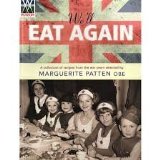I experimented with another recipe from Marguerite Patten‘s book, We’ll Eat Again today; Potato Cheese
 Adjusting the ingredients for only one person, and substituting cabbage for parsley, I used 8 oz mashed potato, 1 1/2 oz grated cheese (almost my whole ration for the week!), 1/4 oz oatmeal and 2 tablespoons of chopped cabbage. (I fried the cabbage in a little bit of bacon fat first to add a little more flavour.)
Adjusting the ingredients for only one person, and substituting cabbage for parsley, I used 8 oz mashed potato, 1 1/2 oz grated cheese (almost my whole ration for the week!), 1/4 oz oatmeal and 2 tablespoons of chopped cabbage. (I fried the cabbage in a little bit of bacon fat first to add a little more flavour.)
Method: Mix the potatoes, half the cheese and cabbage together. Add salt and pepper to taste. Turn the mixture into a shallow dish, cover the mix with the remaining grated cheese and all the oatmeal. Put under grill to brown. I added a side dish of red cabbage coleslaw for colour. Even reducing the portions/ingredients, I still found it too much to eat at one sitting, but it tasted really good and the oatmeal and melted cheese added both flavour and texture to what was, essentially, mashed potatoes!.
I am, however, a little concerned about my Vitamin C intake, especially with no citrus fruits available. In We’ll Meet Again, Marguerite Patten offers not just recipes, but also nutritional advice from the time. According to the wartime nutritionists, everyone needed at least 1,ooo units of Vitamin C every day.
(Here’s a breakdown from the foods I’ve already prepared today.)
8 oz cooked potatoes: 480
1 oz cooked cabbage: 70
2 ozs raw cabbage: 200
I wasn’t able to find the Vitamin C values found in carrots defined in units, but all books agree it’s pretty high.
So if my maths is correct, even without carrots, I’ve had 750 units of Vitamin C out of the wartime recommended 1,000 and it’s only lunch time. Not bad
On to news reports from The Glasgow Herald from October 23rd, 1944. (If you click on the link I’ve supplied, you’ll find that they’ve combined both the papers from the 23rd and 24th in the one link.) Six pages again. Blackout time for Glasgow: 6.28pm until 7.36am.
I continue to find myself much more interested in The Home Front aspect of the news. Perhaps that’s because the actual war news is all positive.
British and Canadians Gain Ground. Breshens and Esschen Captured.
Patton’s New Push.
US Progress in the Philippines.
Another Hungarian Town Captured.
Eighth Army Forces (in Adriatic sector) Drives Germans Back in Swift Advance.
There’s definitely a sense that the end of the war is only a a matter of time. Especially with the following headline: Public Houses Open on Victory Day. If Victory Day should fall on a Thursday, the half-day holiday usually held on that day will de disregarded and the ordinary permitted hours will be observed. No Liquor will be sold for carrying out throughout the day.
Typhoid at Greenock. Three case of typhoid had been reported in Greenock in the past two months. In each case the patients had eaten shellfish gathered from the shores of the Firth of Clyde. Although it couldn’t be proven that this is where they had contacted the disease, ‘Shellfish should be regarded as unfit for food unless thoroughly boiled for full half-an-hour.’
Miners employed at Fortissat Colliery, Shotts, and at Ferniegair Colliery, Hamilton, decided at meetings yesterday to resume work today. Some 450 men were involved in the disruptions.
The SYHA (Scottish Youth Hostel Association) was actively looking to buy mansions or other buildings suitable for Youth Hostels, for either immediate or post-war use.










